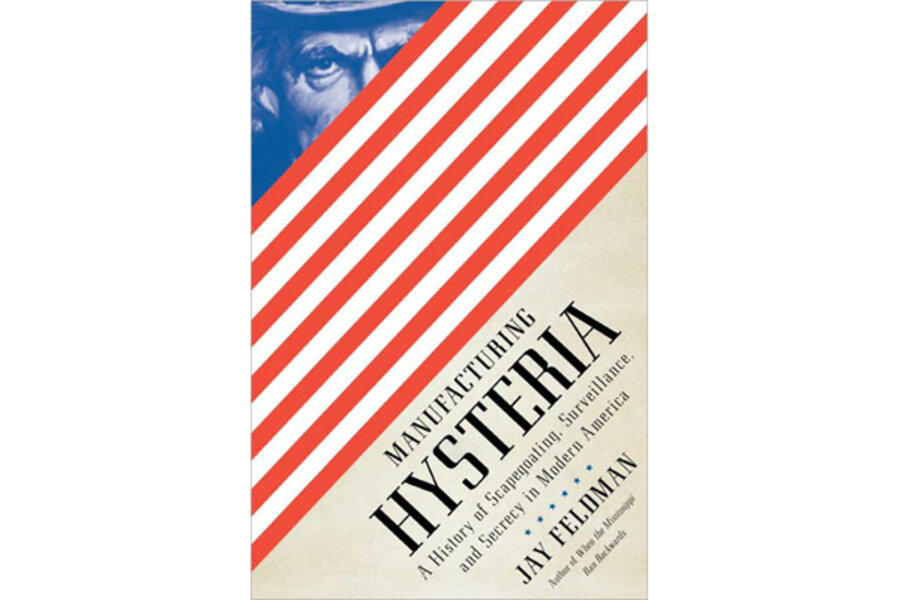Manufacturing Hysteria: A History of Scapegoating, Surveillance, and Secrecy in Modern America
Loading...
The United States was founded on the notion of being open to all, with malice toward none. At the same time, the US has a history of being hostile to the “other,” be that racial, political, sexual, or economic. Historian and writer Jay Feldman tracks that hostility from World War I to now, when disputes over immigration roil the country state by state. The picture he paints in Manufacturing Hysteria: A History of Scapegoating, Surveillance, and Secrecy in Modern America is dark.
Among the key agents of darkness: J. Edgar Hoover, from his time with FBI precursor the Bureau of Investigation to his discredited end; several presidents, particularly Woodrow Wilson, Franklin Delano Roosevelt, and George W. Bush; and first among equals, Sen. Joe McCarthy (R) of Wisconsin, the heartland demagogue who inadvertently helped liberalism regain its voice.
Feldman launches his scapegoating inquiry with an anecdote about rural Illinois in April 1918, when the good folk of Collinsville lynched Robert Paul Prager, a German immigrant, alleged Socialist, and suspected spy. Prager’s murder attests to the toxic patriotism of president-to-be Warren G. Harding, who helped to stir the pot with his remark that “the only place for Germany’s ‘miserable spies … is against the wall.’ ”
Over the past 90-plus years, this attitude led to the persecution of German, Mexican, and Japanese-Americans, both native and second-generation. It first was crystallized in 1918 with passage of the Sedition Act, a law curtailing free speech that ultimately led to the demise of the International Workers of the World (aka the Wobblies).
World War I, writes Feldman, signaled “the birth of the surveillance state,” which gave arms manufacturers “enormous influence in governmental affairs,” and began to make “governmental secrecy” an “operational norm.” All paved the way for the “red scare,” culminating in the Palmer raids, which decimated the tiny US Communist party and led to the deportation of those suspected of Bolshevik sympathies.
In the early ’30s, hundreds of thousands of Mexicans were deported from Texas and California and, as the Depression deepened, “the notion that illegal aliens were occupying jobs that would otherwise go to American citizens took on increased currency,” Feldman writes.
During the ’40s, FDR, tipped off by the FBI and the military as to the existence of an imminent “fifth column,” issued Executive Order 9066, authorizing the evacuation of more than 100,000 immigrant Japanese (Issei) and American-born Nisei from the West Coast.
In both cases, agricultural interests played a key role, assuming a racist nativist stance. “The evacuation and internment of the West Coast ethnic Japanese is a serious blot on Roosevelt’s legacy, but it is in keeping with his often cavalier disregard for civil liberties,” Feldman writes.
The “red scare” of 1919 was revived in the early ’50s when Senator McCarthy ruled the political field, enabled for far too long by politicians too timorous to challenge him – including President Eisenhower, who issued an executive order of his own in 1953 mandating loyalty to the country.
This led to nearly 1,000 employees in the US State Department losing their jobs because of “sex perversion”; meanwhile, Ike’s Operation Wetback resurrected the Depression-Era scapegoating of Mexicans and Mexican-Americans. And Hoover launched the Counterintelligence Program-Communist Party USA, or COINTELPRO – without telling the administration.
Feldman spends little time on the administrations of Jimmy Carter, Ronald Reagan, and Bill Clinton, but touches on the George W. Bush years, when the USA Patriot Act was passed and the Terrorism Information and Prevention System, a sophisticated nationwide snitch operation, failed to gain purchase; apparently many Americans balk at the notion of spying on each other.
At the same time, increasing technological sophistication facilitates the systematization of political paranoia and makes surveillance harder to detect. “Manufacturing Hysteria” is a cautionary, liberalizing history – and a book that serves as a philosophical call to arms.
Carlo Wolff is a freelance book critic in Cleveland.






